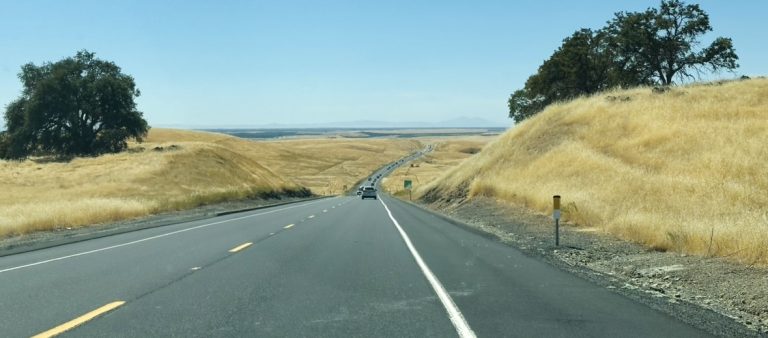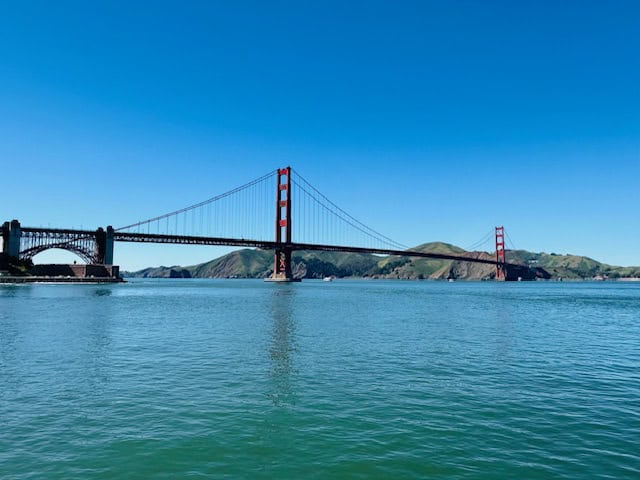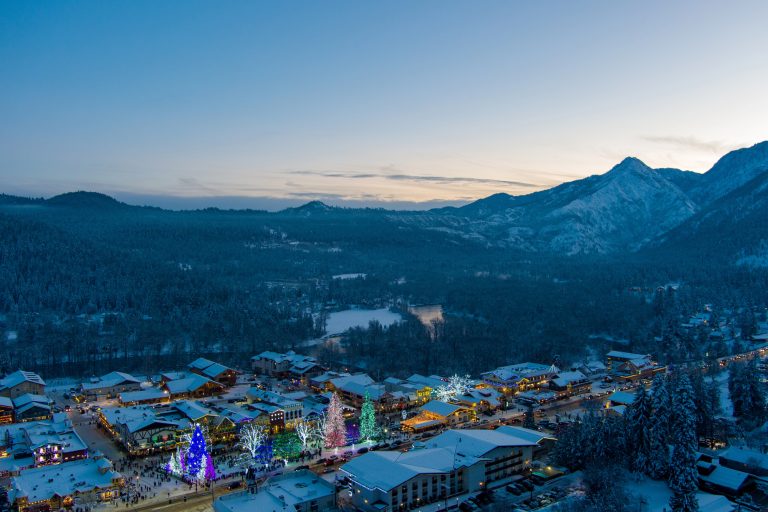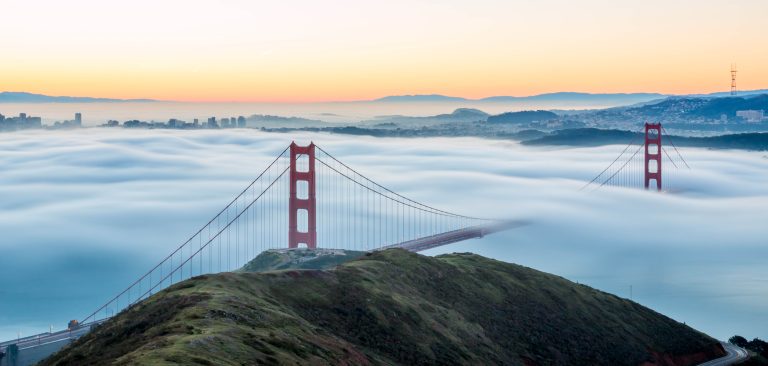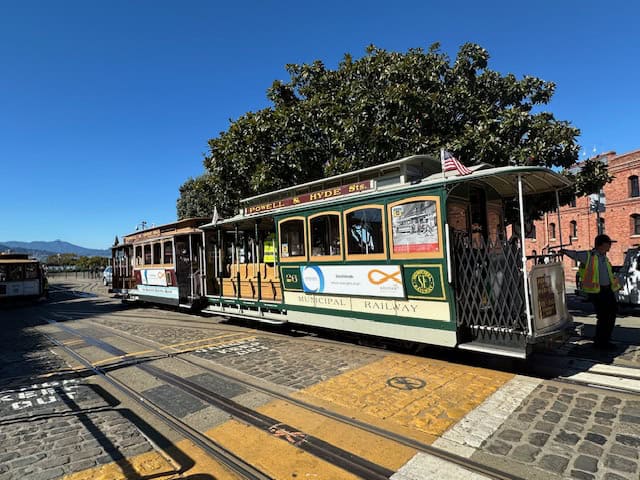Wander Now Travel uses affiliate links and participates in the Amazon Services LLC Associates Program. If you make a purchase, I may earn a small commission- at no extra cost to you. I only recommend what I trust and use. Your support helps me continue creating helpful travel content. Read my disclaimer for details.
There’s something truly unforgettable about the moment you leave behind San Francisco’s familiar fog for the crisp mountain air of Yosemite National Park. I still remember my first drive over the Bay Bridge, wind whipping through the open air as I felt the salty air shift to the sweet scent of pine. One moment you’re crossing the Bay Bridge with the city skyline fading behind you and before long, you’re watching the granite cliffs and waterfalls fill your windshield. This San Francisco to Yosemite road trip isn’t just about getting from point A to point B; instead, it’s a journey full of small-town foodie gems, scenic byways and hidden stops that make the drive as memorable as the park itself.
I’ve been driving up to Yosemite from the Bay Area for over 30 years, and I’ll share the best driving routes, insider tips and my personal favorite pit stops. Here’s everything you need to know to make the most of the adventure.
San Francisco To Yosemite 3-Day Road Trip Itinerary Overview
You’ll get the whole California experience, traveling through windmills on the Altamont hills, cow and horse pastures, apple and almond orchards in the Foothills (which display beautiful white and pink blooms in the Spring) and through Gold Rush towns.
There are two main routes from San Francisco to Yosemite, but I suggest taking Highway 120 on your way there for the most direct drive, plus it’s packed with Old West charm, Cowboy culture and Gold Rush history. Then, head back via Highway 140 so you can experience a completely different set of sights on your return trip.
📍Day 1: San Francisco to Livermore to explore wineries
📍Day 2: Livermore to Cowboy Towns & Gold Country Towns, Sonora
📍Day 3: Gold Country & Old West Towns to Yosemite’s Gateway Town, Groveland
Need to rent a Car? Get the best rental car deals with Discover Cars:
Road Trip Day 1: San Francisco to Livermore
You’ll start your road trip with a roughly hour-long drive over the Bay Bridge and arrive at your first stop in Livermore, where you’ll find inviting coffee shops, outlets, boutique shops and small-town charm in Livermore Valley’s wine country.
Morning
Grab a latte at Story Coffee, a cozy spot known for its lavender and vanilla-infused drinks, or stop by The Press an Artisan Cafe featuring craft coffee and a seed oil-free kitchen. Both of which are located in downtown Livermore and just a 5-minute drive away from the longest burning light bulb.
If you like quirky history or are just intrigued by this, like I am, then you can head to the Livermore-Pleasanton Fire Station to see a light bulb that has been burning since 1901! Visitors can see the Centennial Light Bulb, the world’s longest continuous burning light bulb, at the Livermore-Pleasanton Fire Station No. 6, located at 4550 East Avenue. This is an active fire station, but you can still view the bulb during public viewing hours from 10:00 AM to 11:30 AM and 3:00 PM to 5:00 PM daily, as long as the station is not busy with calls. This is a fun, one-of-a-kind quick stop.
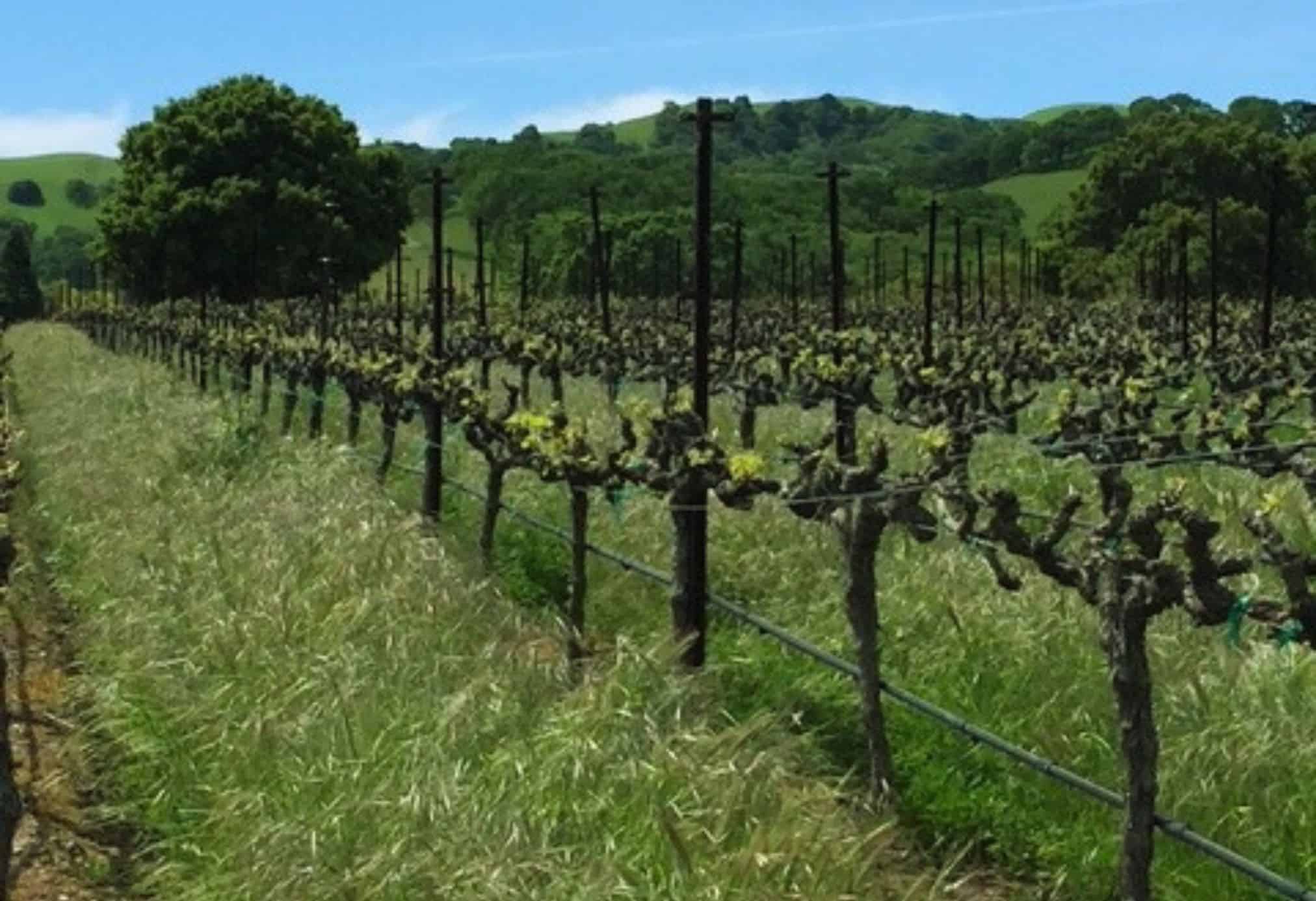
Afternoon
Head to a 4-hour winery tour through 3 wineries, often including local favorites like Las Positas Vineyards, Concannon Vineyards, or Garre Winery, for tastings, lunch and a behind-the-scenes look at what makes this wine region so special.
Book your Livermore Valley Wine Trolley Tour
This popular Winery Tour is likely to sell out and includes a custom-ordered lunch, so be sure to book early. Each stop offers something different, from scenic vineyards to family-run charm featuring Livermore’s best pours, while someone else handles the driving.
If wine tasting isn’t your thing, then I suggest playing this exciting Scavenger Hunt throughout the town.
Evening
Round out your day with a bit of playtime at Da Boccery, located on Vineyard Avenue. This local hangout combines bocce, shuffleboard, axe throwing and even an arcade. If you prefer something more low-key, head back downtown to the Local Bar or V & W Club, both of which offer my favorite game, shuffleboard.
My favorite dinner spot is Sauced BBQ & Spirits, which serves up big flavors and southern hospitality. The menu features smoky brisket, saucy ribs and crispy burnt ends. Whether you sit outside on the patio or inside under the neon lights, it’s a fun, no-fuss place to kick back and savor a true Livermore favorite.
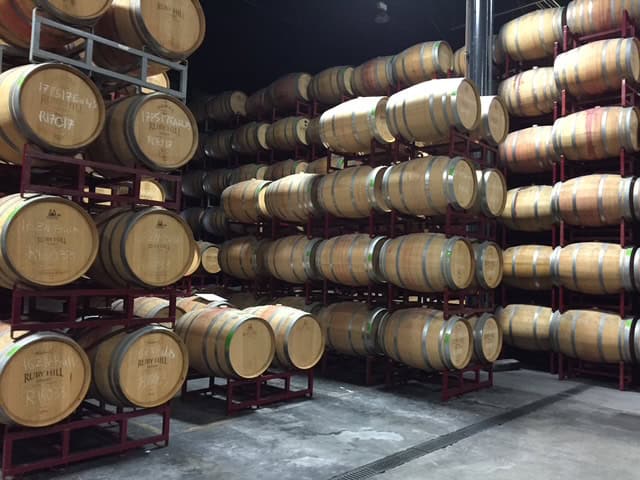
Where to Stay in Livermore’s Wine Country
Best Budget Option: Hilton Garden Inn
✨Comfortable & practical- Modern room featuring mini-fridges, workspaces and plush bedding.
✨Great amenities- Guests can enjoy the heated pool, fitness center and on-site restaurant and bar.
✨Convenient location- located just off the freeway and central to wineries, trails and the shopping Outlets.
Best Mid-Range Option- Quaint 2-Bedroom
✨Peaceful wine country stay- this private 2-bedroom home offers a quiet retreat surrounded by rolling vineyards.
✨Offers home comforts- you’ll have the entire place to yourself, complete with cozy living spaces, a well-equipped kitchen and inviting outdoor areas.
✨Convenient- Tucked away for privacy, yet just minutes from downtown Livermore.
Best Luxury Option: Purple Orchid Resort & Spa
✨Peaceful vineyard retreat- Elegant rooms with fireplaces, jetted tubs and vineyard or garden views.
✨Relax & indulge- Enjoy the outdoor pool, full-service spa and evening “Gathering Hour” with local wine and olive oil tastings.
✨Close to everything- Just minutes from wineries and downtown, but offering wine country charm.
Road Trip Day 2: Livermore to Gold Country
For your second day on the road, you’ll drive for about an hour from Highway 580 to Highway 120 through the Altamont Hills Wind Farms and view giant wind turbines blowing in the breeze. Due to the vast amount of wind this area receives, be prepared to keep a steady hand on the wheel as your car might get blown a bit.
Morning
Here are a few breakfast suggestions in Livermore before you hit the road. Monica’s of Livermore is located in a beautifully restored historic building downtown and it’s known for farm-to-table breakfast, house-baked pastries like my favorite lemon ricotta pancakes. My other favorite spot is Mornings on First, known for their creative lattes, fresh pastries and hearty brunch favorites like their breakfast burrito.
If there’s one place I always stop, it’s Oakdale. Known as the “Cowboy Capital of the World,” this town is more than rodeo history; it’s a treasure trove of delicious roadside eats.
Afternoon
My go-to lunch stop in Oakdale is Farrarese’s Italian Deli and my go-to order is the ham sourdough roll with pasta salad on the side. It comes out warm, fresh from the oven and tastes like comfort in sandwich form.
I also like to indulge in Roberts Ferry Gourmet’s famous almond butter milkshake. Creamy, nutty and a perfect representation of California’s largest crop. I also like to grab a bag of caramel popcorn for the drive and it disappears faster than you’d think.
Next, saddle up for a glimpse of California’s Wild West roots at The Oakdale Cowboy Museum, tucked inside the town’s historic train depot on F Street. This small, but fascinating glimpse of history celebrates Oakdale’s deep ranching and rodeo heritage with exhibits of saddles, spurs and cowboy memorabilia. It’s an easy, 20-minute stop that will transport you back in time.
Located just off Highway 120, another must-stop spot is The Oakdale Cheese Factory. Family-owned with deep Dutch roots, the shop is known for its handcrafted Gouda cheeses, which are made on-site using traditional methods. Visitors can watch the cheesemaking process through large viewing windows, sample a few varieties. I always leave with a wedge or two of their legendary Gouda, then wander outside to my favorite spot by the pond or see the friendly farm animals. It’s a great place to slow down and savor a little local flavor before heading up to Gold Country.
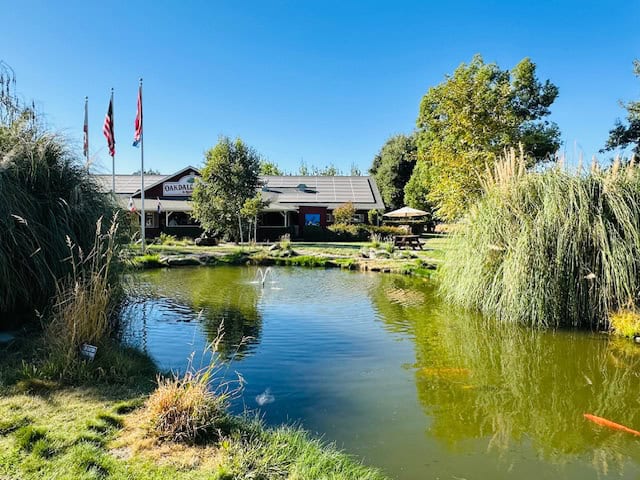
I also love to stop off at the Historic Knights Ferry Covered Bridge. A quick detour off Highway 120 leads to the longest covered bridge west of the Mississippi that was built in 1848.
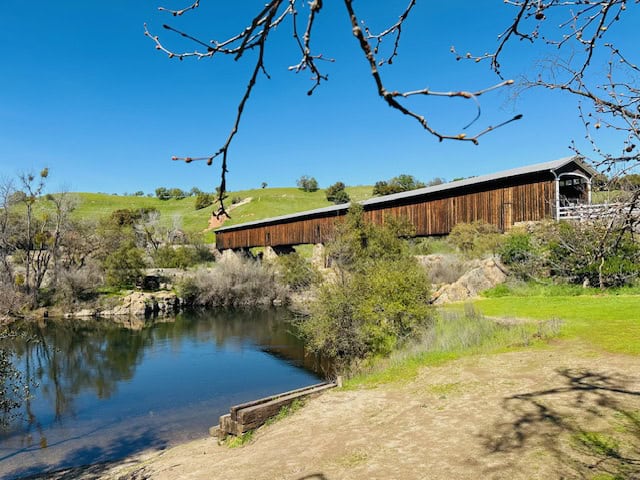
Just outside Oakdale along Highway 120, you’ll start to see a lot of ranches and fruit farms. If you’re lucky and visit during the early Spring, then you’ll get to see the fruit trees and almond orchards in blossom, dotted with pink and white flowers and when the wind starts blowing the blooms off the trees, you’ll witness a beautiful phenomenon known as “California snow”.
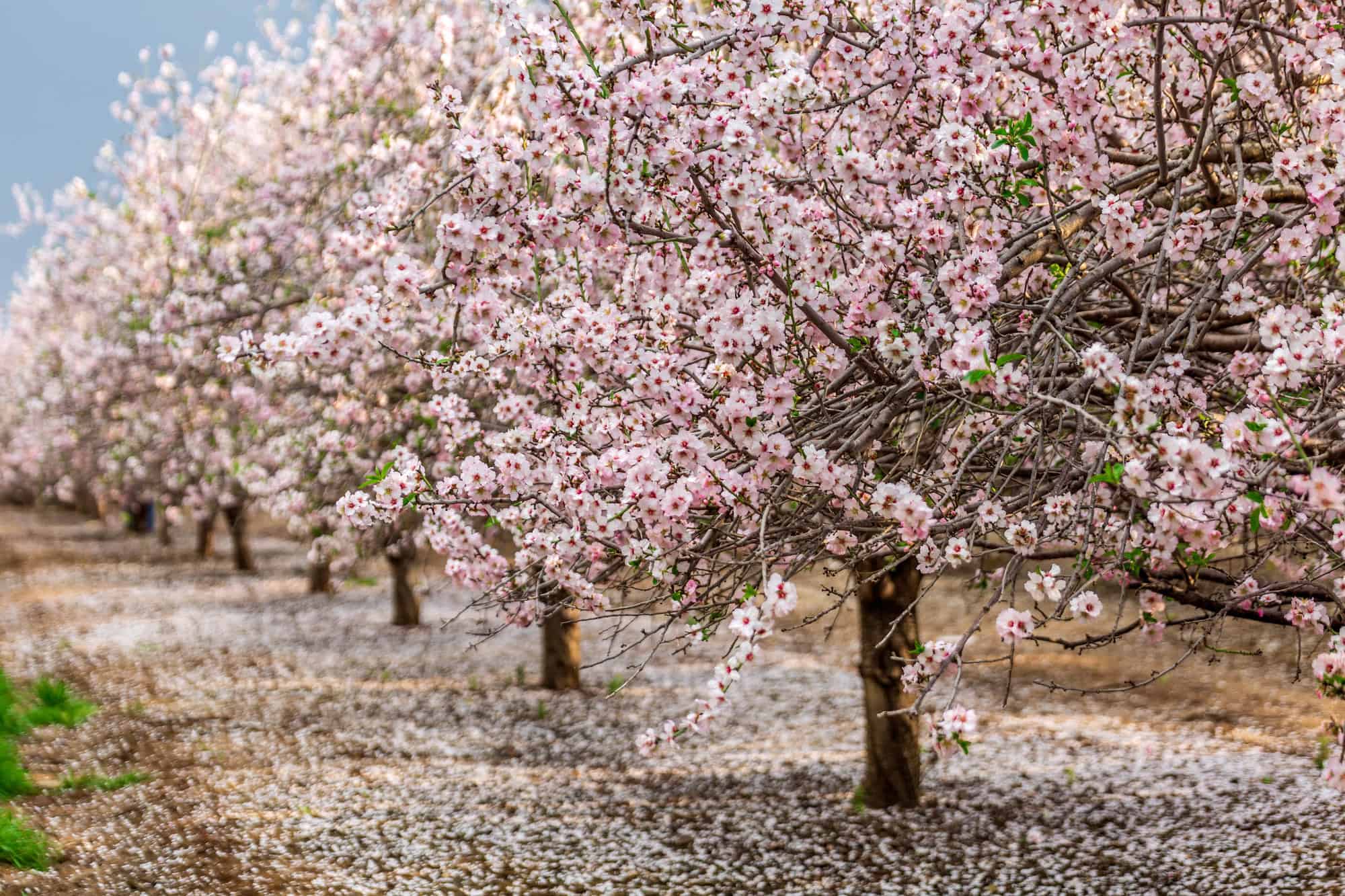
Bloomingcamp Ranch is one of those roadside stops that feels straight out of a simpler time. What began as a family sheep ranch has grown into a cozy apple orchard and bake shop where everything smells like butter, cinnamon and fresh fruit. Visitors come for their famous homemade pies, seasonal treats and farm-fresh goodies. Open Wednesday through Sunday from 9:00 AM to 4:00 PM, it’s a must-stop spot.
Spend an afternoon steeped in Gold Country charm with a visit to Railtown 1897 State Historic Park in Jamestown. Hop aboard a 45-minute scenic train ride that winds through rolling foothills and oak-dotted landscapes aboard a restored steam or vintage diesel locomotive. Before or after your ride, tour the working roundhouse and historic locomotive shops. I have taken this train ride a few times and it is always fun to see the Number 3 steam train in action. It is affectionately known as the “Movie Train” because it’s been used in over 100 films, most notably Petticoat Junction (and they still have the water tower that you can view from the train!), Little House on the Prairie, High Noon and Back to the Future 3.

Evening
After your ride, head down the street to downtown Jamestown and walk through the Old West stores on Main Street. For dinner, I have two options. I have eaten at both restaurants, and they are both excellent choices; it just depends on what kind of food you are in the mood for. The first option is at the Jamestown Hotel Restaurant, which is known for its welcoming and historic atmosphere. It is in a beautifully restored Victorian setting and my favorite dish is their signature smoked brisket sandwich. It is a beloved landmark since 1919, but its history goes way back to the 1850s. My second option is the Morelia Mexican Restaurant across the street. Their house-made tortilla chips and salsa, as well as their sizzling fajitas and sauce-laden enchiladas, are delicious.
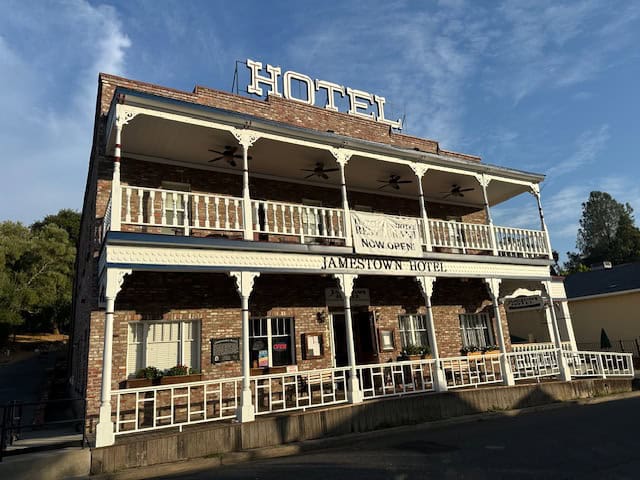
Where to Stay in Sonora’s Gold Country
Best Budget Option: Hotel Lumberjack
✨Modern comfort with a rustic twist- This boutique-style lodge blends contemporary design with a nod to Sonora’s Gold Country roots.
✨Thoughtful details throughout- Rooms come equipped with mini-fridges, microwaves and walk-in showers, plus free Wi-Fi and air conditioning.
✨Perfect location- Right in the heart of downtown Sonora, it’s just steps from local shops, restaurants and historic sites.
Best Mid-Range Option- Apple Valley Cabin
✨Peaceful and private- Tucked away on a few quiet acres outside Sonora, this cozy cabin offers a true escape with all of the comforts of home.
✨Modern comfort meets rustic charm- Thoughtful touches like a fireplace, private patio and BBQ area, as well as modern amenities like Wi-Fi and air conditioning.
✨Close to everything, yet wonderfully secluded- Located just a short drive from downtown Sonora and scenic spots like Indigeny Reserve, it’s the perfect base for exploring Gold Country by day and relaxing under the stars by night.
Best Luxury Option: The Inn on Knowles Hill Bed & Breakfast
✨Historic charm with a view- Perched above downtown Sonora in a lovingly restored 1920s mansion, this hilltop inn combines vintage elegance with sweeping views of the Gold Country below.
✨Breakfast worth waking up for- Each morning begins with a beautifully plated, multi-course breakfast filled with fresh-baked pastries, local flavors and a touch of indulgence served on fine china.
✨Modern comfort meets old-world style- Every room has its own personality, blending antique furnishings with modern amenities.
Day 3: Gold Country to Yosemite & a pit-stop in Columbia
The drive from Sonora to Groveland winds through scenic Sierra Nevada foothills, where golden meadows and oak-dotted hills gradually give way to pine forests and mountain curves.
Morning
First, we’ll take a pit stop by heading to Columbia State Historic Park, which is less than 10 minutes away and one of California’s best-preserved Gold Rush towns, where the 1850s come alive on the wooden boardwalk. It’s completely free to walk around and experience the ambiance of an old west town. You can pan for gold, ride an authentic stagecoach, or, our favorite activity, bowling in the old-fashioned wooden bowling alley, where pins are still set by hand. It’s also fun to stop by Kamice’s Photographic Establishment to dress in period costume and take home an “old-timey” portrait. When it’s time for a treat, grab a cone at the Fallon House Ice Cream Parlor, indulge your sweet tooth at Nelson’s Candy Kitchen, or enjoy tea and homemade desserts at Columbia Kate’s Teahouse. If you’re looking for a full meal, enjoy homestyle comfort at the City Hotel Restaurant & What Cheer Saloon.
Afternoon
Then, drive 45 minutes up the hill to arrive in another historic Gold Town and your final destination, Groveland, a historic gateway town just outside Yosemite. Start your afternoon with lunch at the Iron Door Saloon, the oldest continuously operating saloon in California, where you can savor a hearty tri-tip sandwich or the famous Iron Door Burger under its rustic tin ceiling and wild west décor.
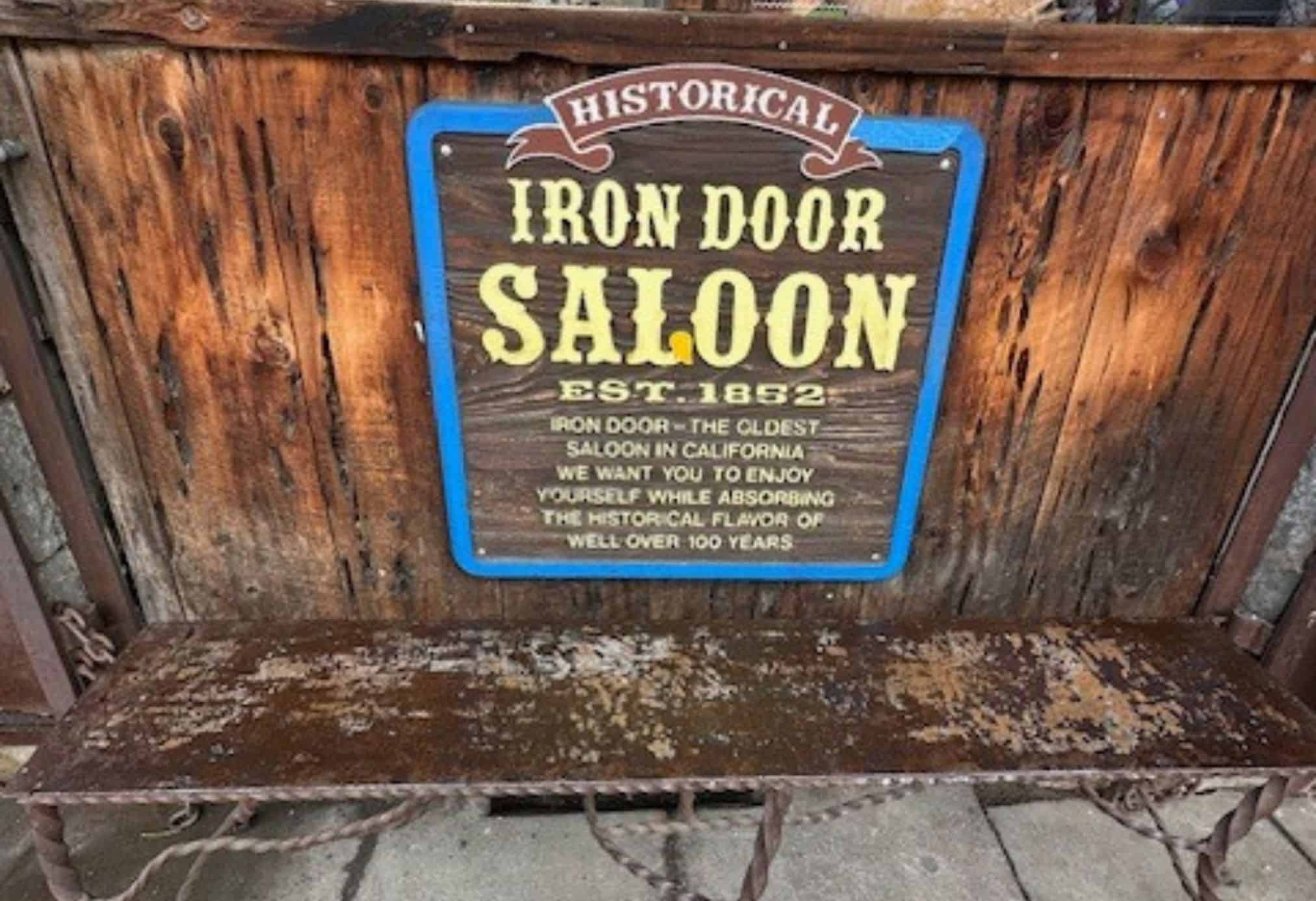
Afterward, stroll down the street to the Groveland Yosemite Gateway Museum, a free and fascinating stop that highlights the town’s Gold Rush history, Native American heritage and early Yosemite pioneers. Once you’ve soaked in the local history, wander Main Street, browse boutiques and pop into Mountain Sage Coffee & Nursery for a lavender lemonade or honey latte amid blooming gardens.
Evening
In the evening, my favorite dinner spot is the historic Groveland Hotel, where you can experience farm-to-table dining and warm Sierra hospitality in their garden in the Summer or inside the historic dining room.
Groveland is a great home base during your Yosemite National Park exploration, as it’s an easy 36-minute drive to the park’s Big Oak Flat Entrance.
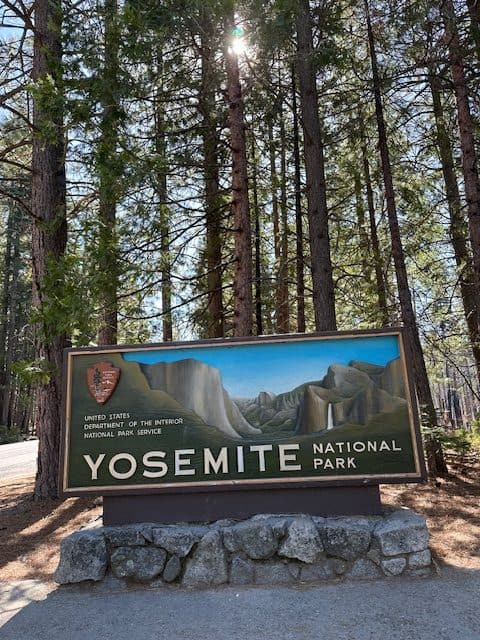
Where to Stay in Groveland (Gateway to Yosemite)
Best Budget Option: Yosemite Westgate Lodge
✨Family-friendly and convenient amenities- Enjoy on-site perks like an outdoor pool, hot tub and picnic area. There’s also a restaurant and general store nearby.
✨Affordable comfort close to Yosemite- Located just 12 miles from Yosemite’s Big Oak Flat Entrance.
✨Clean, quiet and accessible basecamp- Guests appreciate the spacious rooms, reliable Wi-Fi, and peaceful surroundings.
Best Mid-Range Option- Rush Creek Lodge at Yosemite
✨Family-friendly resort with modern amenities- Spacious rooms, suites and hillside villas are designed for comfort and convenience with on-site dining, a general store, pool, hot tubs and a full-service spa.
✨Unbeatable Yosemite location- Located just a mile from Yosemite’s Big Oak Flat entrance, this lodge provides easy park access.
✨Exceptional value & community vibe- Guests love the welcoming staff, daily activities like s’mores by the fire and guided nature walks.
Best Luxury Option: Firefall Ranch Yosemite
✨Spacious, Modern Cabins with rustic charm- beautifully designed 1 and 2 bedroom cottages featuring full kitchen, cozy fireplaces and private patios.
✨Prime location- Just 22 minutes from the Big Oak Flat entrance to Yosemite National Park.
✨Resort-style amenities & Family-friendly comfort- guests love the outdoor pool, firepits, scenic walking trails, free bicycles, daily activities and welcoming staff.
Road Trip back to San Francisco via Highway 140
This route will take you back through Yosemite for one last look at the beautiful waterfalls and granite cliffs.
Morning
Leaving Yosemite through the Arch Rock Gate, following Highway 140 as it winds beside the Merced River, is one of California’s most scenic drives. In Spring, make sure to stop at the Hite Cove Trailhead, where the hillsides explode with wildflowers like poppies, lupine and Indian paintbrush. The riverside hike offers one of the best wildflower displays in the Sierra Nevada and is a beautiful farewell to Yosemite’s wilderness before you return to San Francisco.
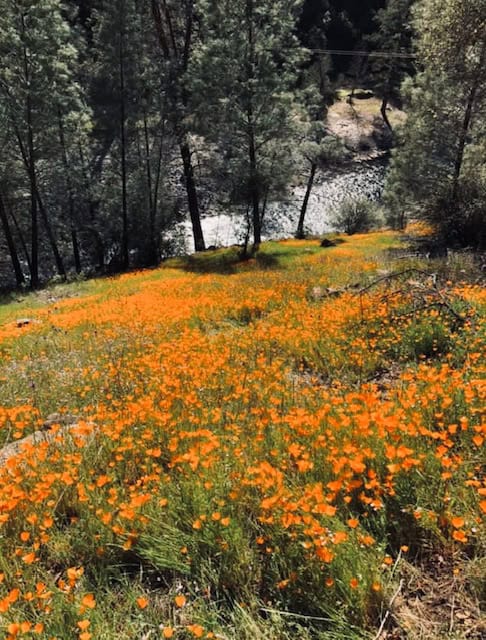
Afternoon
Continue on Highway 140 for about an hour to the Gold Rush town of Mariposa, a perfect place to stretch your legs and soak up more of California’s history.
Explore the Mariposa Museum and History Center for fascinating exhibits about the area’s mining past or visit the California State Mining and Mineral Museum to see one of the largest collections of gold and gems in the state, including a 13.8 pound gold nugget. Then, stroll down Main Street, where you’ll find charming boutiques, antique stores and local art galleries. Grab lunch or dinner at the nostalgic Happy Burger Diner, famous for its wall-to-wall movie posters and my favorite flavorful burgers and shakes.
Before getting back on the road, treat yourself to a coffee or homemade pastry from the Sugar Pine Café or 1850 Restaurant & Brewery.
Evening
From there, drive another 2 hours and 45 minutes, following the rolling foothills west toward San Francisco, watching the pine forests fade back into golden grasslands and cityscapes.
Best Time of Year for a San Francisco to Yosemite Road Trip
The beauty of a San Francisco to Yosemite road trip is that it’s doable year-round, but the experience changes dramatically with the seasons. Choosing the right time depends on what you want to see and your preferred travel style.
Spring- Waterfalls!
- Why go: Snowmelt feeds Yosemite’s famous waterfalls. Wildflowers and poppies, California’s state flower, bloom along the foothills.
- What to know: Each February, Yosemite’s Horsetail Fall briefly transforms into a glowing “firefall” as the setting sun strikes the waterfall at just the right angle, making it appear as if molten lava is flowing down the cliff. Reservations will be required to enter the park. Additionally, some higher-elevation roads, such as Tioga Pass, may remain closed until late May or early June.
Summer- Long Days and Full Access
- Why go: All park roads and trails are typically open, giving you full access to Glacier Point, Tioga Road and high-country hikes.
- What to know: Summer brings heavy crowds and traffic. My recommendation is to start early in the day and book accommodations far in advance. Reservations will be required to enter the park typically on Memorial Day weekend and from mid-June through mid-August and Labor Day weekend.
Fall- Fewer Crowds and Golden Colors
- Why go: Cooler weather and smaller crowds make it one of the most relaxed times to visit. The aspens in the valley glow gold, and Yosemite Valley is crisp and quiet.
- What to know: Some services and high country roads begin to close by late October.
Winter- Snowy Magic and Quiet Trails
- Why go: Yosemite transforms into a winter wonderland, with snowy cliffs and far fewer visitors.
- What to know: Chains or an AWD vehicle may be required and higher roads like Tioga and Glacier Point close for the season. Stick to HIghway 140 for the safest winter drive.
Pro Tip: If it’s your first visit, late Spring to early Summer (May-June) is the sweet spot. You’ll catch roaring waterfalls and longer daylight without the peak Summer crowds.
Tips for an Amazing Trip
A successful and stress-free road trip isn’t just about where you stop along the way, it’s also about what to bring with you.
Road Trip Essentials
- Snacks + Drinks- reusable water bottle with a National Park theme, fruit, granola bars, road trip nibbles and my new favorite candy, JoyRide, with less sugar and no dyes.
- Navigation- download offline maps for patchy service
- Car Prep- check tires, oil and make sure you have a full tank before the foothills
Clothing + Comfort
- I suggested wearing layers for those foggy mornings in San Francisco, and they will also come into play in Yosemite. Even though the Central Valley may be hot, you’ll experience cool evenings in Yosemite due to its elevation at 3,966 feet (1,209 meters).
- Comfortable shoes for roadside strolls and hiking
- Sun protection- hat, sunscreen and sunglasses
Gear for Yosemite
- Camera or smartphone to capture those iconic views
- Daypack for exploring
- National Park Pass if visiting multiple days and multiple parks
Seasonal Considerations
- Winter- Tire chains or an AWD car will be required for entry and gloves, hat and heavy coat are a must.
- Summer-Bring extra water, bug spray, sunscreen powder and cooling towels
- Spring/ Fall- Waterproof jacket and sturdy shoes
Timing is Everything
- Leave San Francisco early to beat traffic (by 7am if possible)
- Travel midweek if possible.
- In Summer, go early for cooler temperatures and in Winter, drive during daylight.
- Fill up your gas tank in Oakdale, as gas gets pricey as you travel up the hill towards Yosemite.
Conclusion: Why this Road Trip is Worth It
Driving from San Francisco to Yosemite isn’t just a way to get from the city to the mountains; it’s a journey that invites you to experience how life was lived during California’s Gold Rush days and how it is still lived today in these small Cowboy towns. The beauty of this drive is how it weaves together the best of Northern California from it’s vibrant cities, rolling foothills, Gold Rush history, foodie finds and finally the granite giants of Yosemite National Park. This trip proves that the adventure doesn’t start at the park gates, it starts the moment you pull out of San Francisco.

